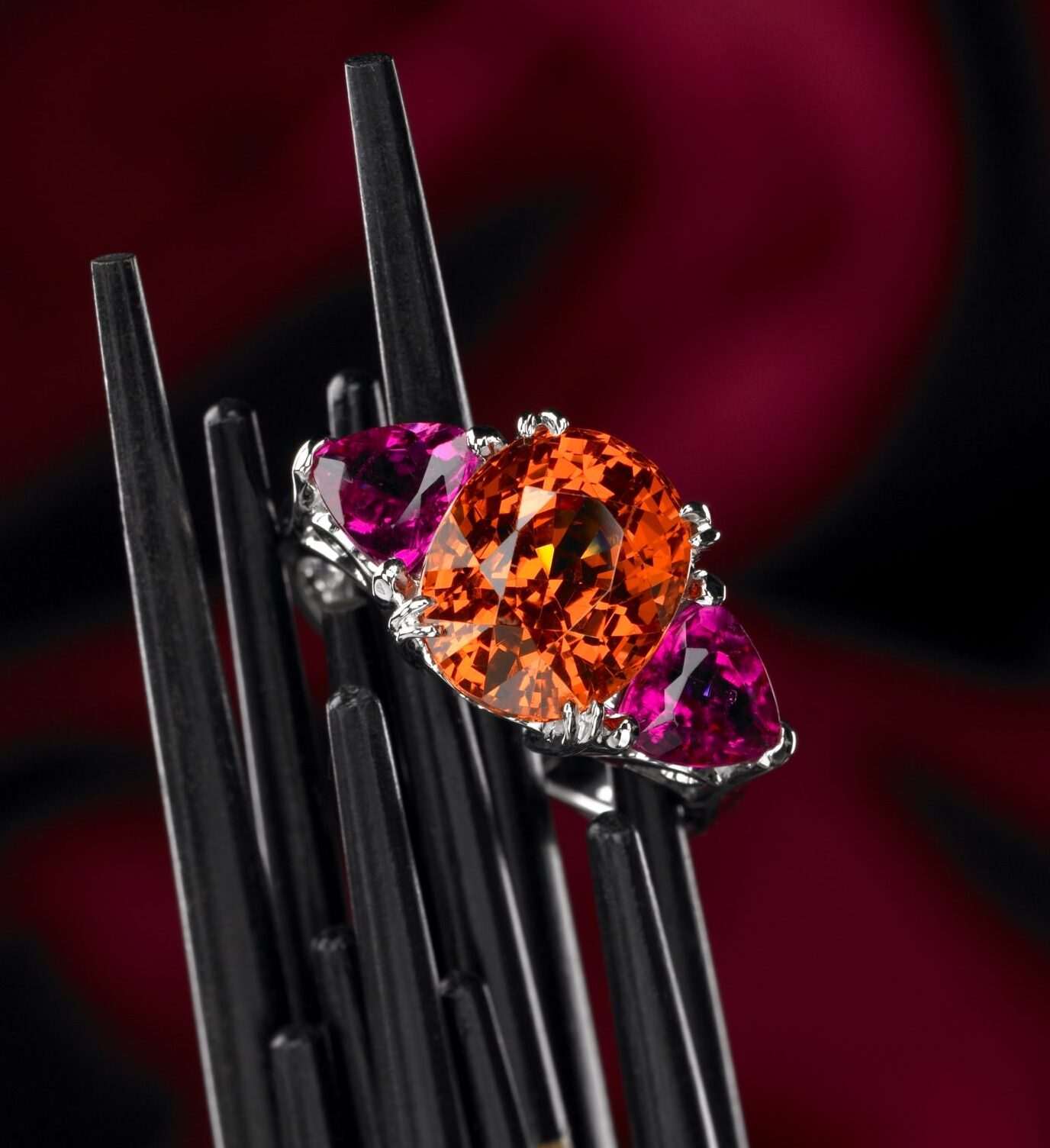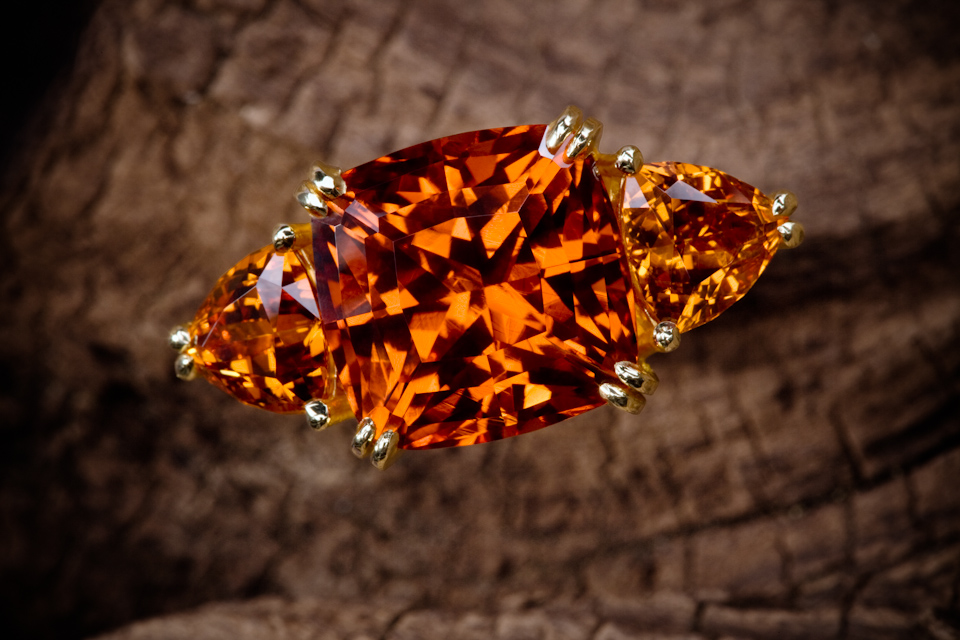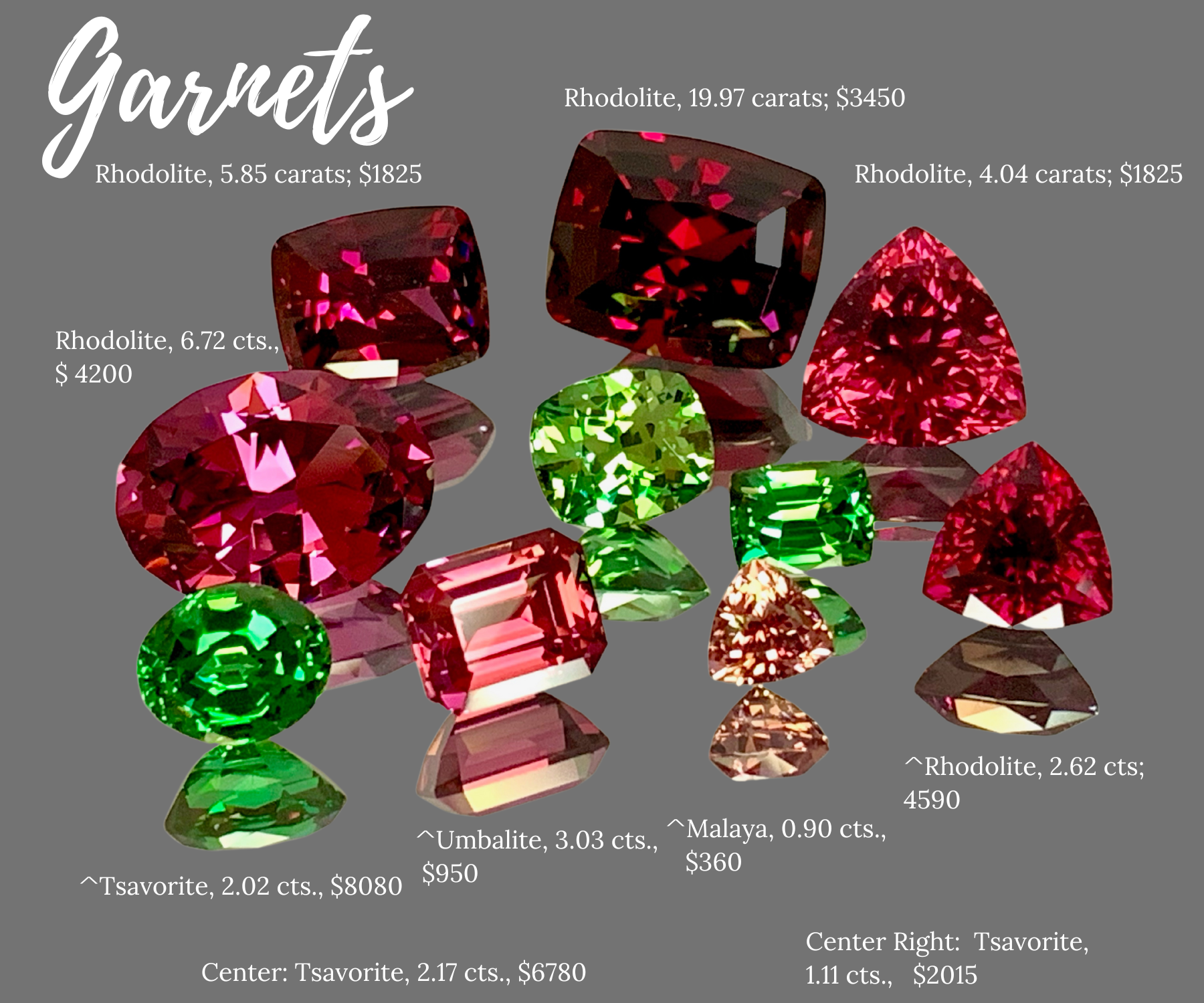Granatum. The word is Latin for “pomegranate” – the seeds of which garnet crystals were thought to resemble.
Mistakenly, many think of garnet as the somber red gem in unexciting jewelry. In actuality, garnet is a brilliant gem found in a wide range of dazzling hues – some garnets even change color in different lights, like the rare gem alexandrite.
Garnet has many jewelry uses and is found in some of the most costly jewelry to some of the most simple. Depending on the quality, size, and cut, it can be the focal point of an exclusive design or provide jewelry manufacturers with a readily repeatable gem for quantity orders.
Cynthia Renée custom “Checkmate” necklace featuring nine carat Spessartite Garnet (Nigeria) set in 14-karat rose gold and worn on an oxidized silver chain. Pendant may be enjoyed when not worn as a standing art object.
Birthstones & Lore
Garnet is the birthstone for January babies and is associated with the strength of heart, blood, and life force, symbolizing love and friendships.
Cynthia Renée custom “Orchid” suite of Tanzanian Rhodolite Garnet and Pakistani Peridot. Learn the Story Behind the Jewel here.
Durability & Wear
Garnet hardness ranges between 6.5-7.5, but remember, there is a difference between hardness and durability, which you can learn about here.
A Knarly Family Tree
Garnet is the family name for a group of minerals that exhibit the same crystal structure and share a similar chemical composition. Within the garnet group, there are more than twenty garnet species, but only five of them are important to us as gemstones, the species pyrope, almandine, spessartite (sometimes called spessartine), grossularite (also called grossular garnet) and andradite.
Then, within these five garnet species important to jewelry, there are varieties and even those varieties can have trade marketing names attached to them.
For example, tsavorite is the vivid green variety of the garnet species grossularite while demantoid is the rich green variety of the garnet species andradite.
What makes the massive garnet family tree even more convoluted is that chemistry between members of the garnet species can mix, forming a type of natural garnet “hybrid” that is a mixture of two or more garnet species. Rhodolite garnet, with its lovely pinkish and purplish hues, is a variety of a mixture of pyrope-almandine species.
Because the garnet group is so diverse, gem garnets come in almost every color.
All garnet types have different sizes and shapes, typical of the variety/species. A two-carat tsavorite garnet is rather large for the variety while a two-carat rhodolite garnet isn’t large but a two-carat red “ant hill” pyrope garnet is large.
Cynthia Renee custom made yellow and rose gold “Fireball” pendant featuring a 21 carat Malaia Garnet.
No Need to Visit Ancestry.com
Gemologists identify the species and variety of garnet based on color and the way light moves through the crystal.
Here, we’ll tour the garnet family by color, since color is what primarily attracts us to a gem, not taxonomy.
In choosing a garnet, go with your eye…and your gut and pick the specific garnet that speaks to you, not its species.
Reddish-Purple-Pinkish Garnets
I recommend focusing on the color and size you desire, not the species.
Color alone does not identify the type of garnet. Several reddish garnets may have a similar appearance yet be different species.
Most rhodolite comes from East Africa and Sri Lanka. Generally, the more pink or purple and less brown a garnet is, the higher the price.
The ring below is with an extremely fine and large Sri Lankan rhodolite, carats set with elongated hexagon-shaped diamonds that the client already had.
An out-of-this world 20 carat rhodolite garnet I found in Sri Lanka set with client’s elongated hexagon diamonds.
And the beauty of smaller rhodolites is shown in the pearl earrings below.
Always remember it is better to choose a fine smaller gem than a larger, lackluster one. Quality over size.
Have you seen the antique jewelry studded with small, dark red garnets? That is pyrope garnet, primarily from the Czech Republic. It is primarily available in only smaller sizes.
There is also pyrope garnet found in the Southwestern United States where it is transported out of the ground by ants while excavating their underground tunnels. It is called “ant hill garnet” or “ant hill pyrope. In the photo below, you can see tiny anthill garnet crystals grouped on a 1-inch diameter round cup.
Magnificent Cynthia Renee purple garnet from Mozambique, approximately four carats
Cynthia Renee Custom “Goddess” ring featuring a 4.47 carat purple Mozambique garnet. Photo by Rockstone
Malaya garnet got its name in the late 1960s after miners in the Tanzania/Kenya borderland were finding garnets that didn’t look like any other. They used the Swahili term “malaya” for them, meaning out of the family.
Gemological studies later showed that malaya garnet is really in the family, though with highly variable proportions of garnet species spessartite-pyrope-almandine-grossular-andradite.
Malaya garnet’s hues are also highly variable combinations of pinkish-orangish-reddish-yellowish. Below is one of the more unusually colored malaia garnets I’ve seen, which I purchased in Tanzania in 2013. As you can see, it could be mistaken for a rhodolite just using sight identification.
One of the finest malaia garnets Cynthia Renee came upon in Tanzania; now in a private collection.
Most malaya garnet has orange/peachy or pinkish hues like the ones in the photos below. I created the pendant as a gift for my daughter’s 18th birthday using the birthstones of my daughter, her father, and me. In creating custom jewelry, I always build in meaning to tell a bit of the wearer’s life story.
Cynthia Renee custom pendant featuring a Malaia garnet, tanzanite, and diamond made for my daughter’s 18th birthday. This pendant has meaning beyond its beauty as it is composed of birthstones of my daughter, her father, and me.
Spicy Colored Garnets
Many garnet species can be orange-colored – you will find them anywhere between the colors of a tangerine, hot cinnamon candy, and rust. The orangish garnets are found in the species spessartite and the varieties hessonite and malaya.
The photo below shows a fantastic collection of the spicier hues of garnet I helped a gem collector assemble over about ten years. The center gem is a rhodolite garnet, and the others spessartite, hessonite, andradite (Mali garnet variety), malaya, and grossularite.
Incredible suite of various types of garnets Cynthia Renee helped a collector assemble over a dedicated ten years. Photo by Weldon
At its finest, spessartite garnet is a hot tangerine color, though more normally seen in orangish-brown. Sometimes you will see it marketed under the name “mandarin garnet.” The more intense and pure the orange and less brownish the stone, the more desired the gem. Spessartite can be so fiery orange, a client and I used it as a focal point to tell a story about her family surviving a fire. Read about it here.
The earrings below feature the juiciest hot tangerine spessartite garnets balanced by equally strong, yet cool electric blue zircons. The client can remove the drops and wear them with other foundation earrings and wear the zircons alone or with other drops.
A pair of juicy 8.03 carat spessartite garnet drop from a 28 carat pair of electric blue zircon. Learn the story behind the jewel here.
In the mid 1990s, there was a large find of spessartite garnet and red tourmaline in Nigeria, both of which are featured in this custom design ring honoring the client’s grandmother, who lived in Nigeria.
Cynthia Renée custom “India” ring featuring 9.57 carat Spessartite Garnet (Nigeria) and 5.46 carat pair of Red Tourmaline (Nigeria) in 14 karat white gold. Learn the story behind the jewel here.
The custom 3-stone ring below is made entirely of spessartite garnets. Notice their hues are different from each other, and from the gems in the rings above reinforcing that you can’t tell a garnet by color alone.
Cynthia Renee custom ring featuring spessartite garnets. We made this ring in 18 karat “bloomed” gold, a technique where the gold alloys are removed from the metal’s surface resulting in a thin pure gold surface that appears matte and soft.
Green Garnets
A vivid green grossular garnet was first discovered in the late 1960s in Kenya’s Tsavo National Park by Scottish geologist Campbell Bridges. A savvy and charismatic man, he took his find to Tiffany & Co. striking a deal for them to become the United States’ sole marketer of this new garnet, which they were able to do for a time. Tiffany coined the trade variety name “tsavorite” honoring its origin. Of course, the name tsavorite conjures up a much more romantic image than green grossular garnet.
Tsavorite is a “one locality” gemstone, only found in the limited geographical area of the Kenya/Tanzania borderlands in East Africa.
This is a Tsavorite for all seasons: top color, clarity and it is mammoth at 10.63 carats.
Set in a custom Cynthia Renee ring in palladium and diamond.
Compare the green in the heart-shaped tsavorite above with that of the oval gem below, an uber-fine seven carat green grossular garnet I purchased in Tanzania several years ago. While the pastel green garnet is rare and covetable, its value is far below that of the ring’s heart-shaped tsavorite.
A remarkable seven carat green grossular garnet from Tanzania, now in a private collection.
Dispersion is the ability of a gem to bend a beam of light into its spectral rainbow hues. The “fire” you see in white diamonds is dispersion.
The fiery green demantoid garnet has greater dispersion than a diamond, though demantoid’s darker body color somewhat masks the dispersive effect. Demantoid’s name stems from the German word for diamond, indicating an adamantine luster.
A collector client asked me to help him with this world-class Russian demantoid garnet weighing approximately seven carats.
Other demantoid garnets are found in Nigeria, Namibia and Madagascar. Though brilliant, they tend to have more yellow, olive and brown in their color mix. The demantoid garnets and the pear-shaped spessartite in the pendant below are from Nigeria.
There are two distinct visual indicators for demantoid garnet: their dispersion and the frequent presence of “horsetail inclusions,” which are thin, radiating fibers of a mineral called byssolite that can look like a horse’s tail flowing in the wind. These inclusions are so unique and characteristic that a demantoid garnet is frequently cut so the horsetails are unmistakably visible. Collectors delight in their fantastic demantoids that have a perfect horsetail inclusion centered in the middle of the gem.
Demantoids over three carats are extremely rare and prices for such rarities are negotiable.
A magnified look into the Russian demantoid featured above showing it’s radiating horsetail inclusion.
So Much Mystery
There are many garnets to become fascinated with, some esoteric and others found in Grandma’s jewelry box.
Speaking of esoteric, the earrings below feature three pairs of yellowish-green “Mali” garnets, found in the West African country of Mali. They have a brilliant fire, being a mix of which are a mix of two garnet groups andradite and grossularite. Though this particular pair of earrings found a home, I do have a few pairs of unset Mali garnets available.
Yellowish-green “Mali” garnets are a mix of two garnet groups giving them a brilliant fire.
As I’m writing, I am also waiting for a rare color change garnet to be finished cutting. I think it will end up about 3 carats and change from a lighter bluish-green to a pinkish color.
Let’s see what happens.
Cynthia Renée full custom design ring in palladium featuring 1.81 carat Tsavorite garnet accented by 0.55 carats of diamond trapezoids and 0.57 carats of diamond rounds.
To earn the name tsavorite, the garnet must be a vivid, rich, darker green, sometimes with a tinge of blue or yellow. If the garnet is a lighter, pastel, or overly yellowish green, gemologically it is called “green grossular garnet” or grossularite, though I’ve seen the marketing names “mint garnet,” or “Merelani garnet” used with this sparkling pastel green gem. Merelani is a mining district in Tanzania where much of this pastel-green garnet is found.
While green grossular garnet doesn’t achieve prices of equivalent quality tsavorite, it is extremely beautiful and coveted in its own right. Tsavorite is very size/price dependent – a two carat fine tsavorite isn’t easy to find, but possible. An equivalent quality five carat tsavorite is extremely rare and priced much higher per carat reflecting that increased rarity.




























